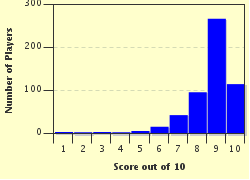Quiz Answer Key and Fun Facts
1. This system of writing involves patterns of raised dots that can be 'read' by the fingertips. The name of this method of communication is synonymous with its inventor. Who was this man who made such an important contribution to the lives of the visually impaired?
2. What a headache! Which of the following compounds, also called acetyl salicylic acid, became a house-hold name as a pain reliever but is actually a registered trademark owned by Bayer AG?
3. Airships have had a mixed history, but the switch from highly flammable hydrogen gas after the Hindenburg disaster in New Jersey in 1937 to inert helium has meant a largely problem free history since then. The following choices are all synonyms for air ships, but can you pick the one named after a German Count?
4. Many different mechanisms are used to temporarily attach items together including buttons, pegs and safety pins. Which well-known temporary fastening method is both a registered trademark and a portmanteau word created from the French words for 'velvet' and 'hook'?
5. 'Walking the Dog', 'Around the World' and 'Rock the Baby' are all common tricks performed using this children's toy. What is the name of this toy, which was registered as a trademark in 1932 by entrepreneur Donald Duncan for $250,000?
6. I thought this was a physics test but the last question asked me which of these four units of energy or power was NOT named after a scientist or engineer! Can you help me by picking the correct answer?
7. The following four words all refer to a non-conformist or rebel. But one of them is derived from the name of a nineteenth century Texas land baron, lawyer and member of the state legislature. Which one?
8. In 1924, Thomas Slate applied for a patent to sell solid carbon dioxide on a commercial scale, after the process for its preparation from the gas phase was established in the nineteenth century. What was the commercial name for this product, which is still synonymous with the substance irrespective of who is selling it?
9. This substance was initially synthesized by an English chemist in 1874 but was not developed further until the Bayer Pharmaceutical Company produced it commercially in 1898 and had the trademark name registered. Ironically, this product was developed as an alternative to morphine as a pain killer, as many patients had developed a strong morphine addiction. So what was this trademarked chemical, which is still known by the same name today?
10. This treatment for milk involves heating it to 72°C (161°F) for 15-20 seconds and then rapidly cooling it, which results in removal of most pathogenic organisms that cause spoilage. What is this process, named in honor of the chemist and microbiologist who modernized it by introducing the rapid cooling step?
Source: Author
MikeMaster99
This quiz was reviewed by FunTrivia editor
LadyCaitriona before going online.
Any errors found in FunTrivia content are routinely corrected through our feedback system.

